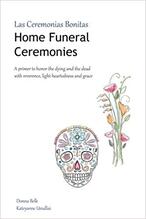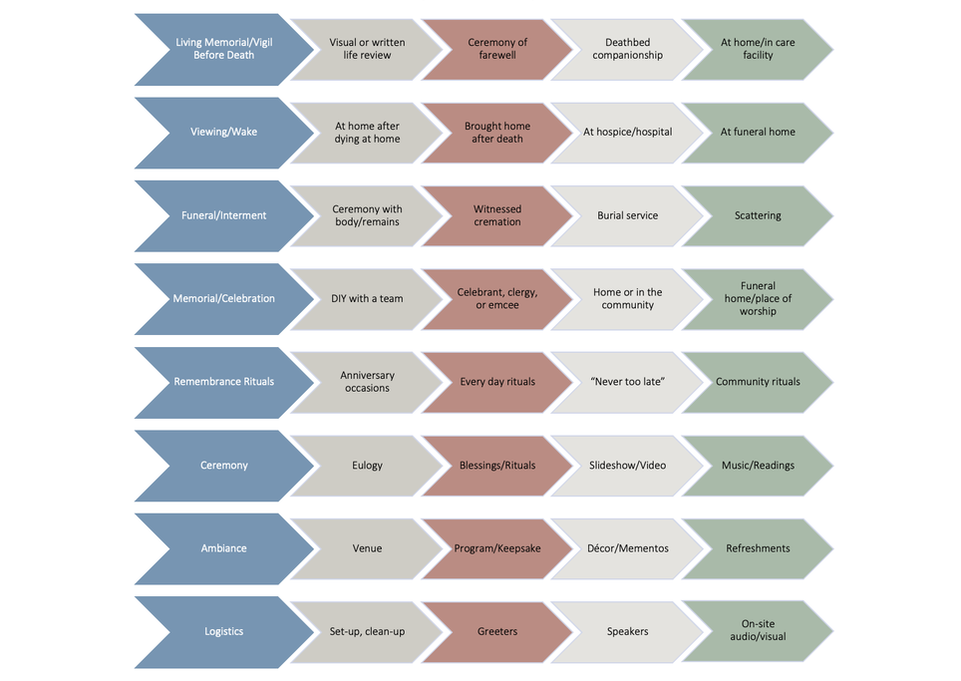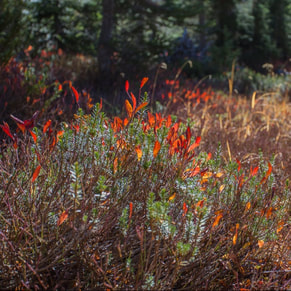Ceremony and Community Engagement
Ritual and ceremony, subtle or elaborate, provides the opportunity to connect more deeply—whether to the deceased, to family and community, to ancestry and culture, or to the natural cycle of life and death. Often we find ourselves creating meaning by marking a moment in simple ways—a spontaneous acknowledgement of what is happening or what has already happened—that has no formal structure but is meaningful and enriching nonetheless. While conventional funeral ceremonies are becoming less frequent, as humans we are hardwired for some form of ceremony to mark the end of a life. What that looks and feels like is entirely up to us. The chart at the end of this page illustrates a range of options for hands-on participation in making meaning through ritual and ceremony.
|
On This Page
|
Before-Death Rituals and Ceremony
In anticipated death, both the dying and their family and friends may have the opportunity to take that time for reflection.
- Legacy Projects in written, spoken, or other form leave a message of importance for descendants. In Jewish tradition, this is called an ethical will (zava'ah, in Hebrew).
- Life Review can smooth the dying process, presenting a chance to tie up loose ends and make meaning of a life.
- Living Memorials are gaining popularity, inviting the dying person's sphere of loved ones into a ceremony of farewell and support while they are there to design and enjoy it.
- Vigils During the Dying Period are meant to comfort the dying and the living, creating community by having someone nearby at all times.
- End-of-Life Doulas are poised to assist families with these aspects of dying, some as volunteers and others for pay.
- Twilight Brigade is an organization of volunteers who ensure that no military veteran dies alone.
- No One Dies Alone is an organization of volunteers who provide a compassionate presence in nursing homes and senior care facilities during the final 24-36 hours of life.
Marking the Moment After Death
By keeping or bringing a person home after death, family – both biological and chosen – friends, neighbors, co-workers, and community members have the opportunity to mark the passing in an intimate, familiar environment. Slowing the pace of activity after the dying period allows everyone space to reflect and to take in what has occurred. The constellation around each person is different and will find their own way to make meaning of the death. (See Types of Ceremonies for more information.) Here are some to consider as a starting point.
For examples of planned and impromptu home funeral ceremonies, see Heather’s Story, Mikaela’s Story, Alicia’s Story, Rich’s Story, Jake’s Story, Karen’s Story and Lashanna’s Story. Read Briar’s Story for creative memorial ceremony examples.
- After-Death Vigils invite others to come into the home to sit with the body for a period of time, often overnight. In the Jewish faith, this is called sitting shiva, where the body is not left alone until burial.
- Viewing, Visitation, Wake are terms used interchangeably in a formal setting, but in the home it simply means that mourners are invited into the home at times agreeable to the hosts over a period of hours or days to witness the death and comfort the living.
- Ceremony of any kind can be conducted at home or at any other location, incorporating clergy, musicians, poets, and others who wish to contribute to honoring the memory of the deceased.
- Memorials are typically held after the body has been buried or cremated, so there is no body present.
- Funeral Services are with the body present, either in the home or at a church or facility elsewhere.
- Graveside Services mark the moment of interment in the earth, giving the family a chance to participate.
- Scattering Ceremony is a gathering of mourners to bury, float, or literally scatter cremated remains in the air.
For examples of planned and impromptu home funeral ceremonies, see Heather’s Story, Mikaela’s Story, Alicia’s Story, Rich’s Story, Jake’s Story, Karen’s Story and Lashanna’s Story. Read Briar’s Story for creative memorial ceremony examples.
Ceremony and Ritual
 Find inspiration in "Home Funeral Ceremonies" by Donna Belk and Kateyanne Unullisi
Find inspiration in "Home Funeral Ceremonies" by Donna Belk and Kateyanne Unullisi
For many, the time around a death is confusing and unsettling, and we often don't feel confident about what we say or how we say it. We have lost the art of condolence. Home funerals give us the opportunity to relearn the language of death within community, and to use it to make sense of what has happened and express our emotions and hopes.
We have come to expect that ceremonies are one-time events, and rituals are only religious. With more people dying and staying in the home for the vigil period, we are learning that ritual is a powerful tool for coping and making meaning that can be spontaneous, individual or collective, or formal.
Religious leaders, ordained clergy, interfaith ministers, and celebrants are all trained to varying degrees to assist families in creating personal and meaningful ceremonies that are story-centered and family-led. (See Types of Helpers for more information.)
The following websites offer free ceremonial resources, such as poems, songs, hymns, quotations, prayers, and other elements for families to use to create their own. Some also describe ceremony features according to the type of event and the time they may be used.
The Inspired Funeral
We have come to expect that ceremonies are one-time events, and rituals are only religious. With more people dying and staying in the home for the vigil period, we are learning that ritual is a powerful tool for coping and making meaning that can be spontaneous, individual or collective, or formal.
Religious leaders, ordained clergy, interfaith ministers, and celebrants are all trained to varying degrees to assist families in creating personal and meaningful ceremonies that are story-centered and family-led. (See Types of Helpers for more information.)
The following websites offer free ceremonial resources, such as poems, songs, hymns, quotations, prayers, and other elements for families to use to create their own. Some also describe ceremony features according to the type of event and the time they may be used.
The Inspired Funeral
Public Announcements of the Death
Who Needs to Be Notified
In the past, it was customary to file a death notice in a paper near where the deceased lived and did business in order to notify known creditors so that they have the chance to make a claim against the estate. It is not required by the state, since the filing of the death certificate with Vital Records is now considered sufficient record and proof. Today, posting a notice in the paper is more of a social convention, letting everyone in your world know that someone has died.
Publishing a Death Notice or Obituary
Families or other support people may file obituaries and memorial notices. A newspaper may ask to see a death certificate if it is not being submitted by a funeral director. While some news outlets may still provide a death notice or obituary as a public service (or as a news item in the case of a public person), today these are typically handled by an advertising department charging by word count, number of lines, or column inches.
Online Memorial Websites are a good way to involve the community by providing a place to post condolences, and share memories and photos. The site can be used to designate nonprofit charity donations and alert people to changes in plans. Typically a funeral home or cremation provider will offer their customers an online posting on their site at no additional charge. To lower costs of a published obituary, a longer version can be posted online with the paid notice including this web link for more details. Some families use Facebook and other social media sites for this purpose. There are also a growing number of online obituary and memorialization sites, many free, such as LifePosts. (See Elements of Ceremonies below for more information.)
In the past, it was customary to file a death notice in a paper near where the deceased lived and did business in order to notify known creditors so that they have the chance to make a claim against the estate. It is not required by the state, since the filing of the death certificate with Vital Records is now considered sufficient record and proof. Today, posting a notice in the paper is more of a social convention, letting everyone in your world know that someone has died.
Publishing a Death Notice or Obituary
Families or other support people may file obituaries and memorial notices. A newspaper may ask to see a death certificate if it is not being submitted by a funeral director. While some news outlets may still provide a death notice or obituary as a public service (or as a news item in the case of a public person), today these are typically handled by an advertising department charging by word count, number of lines, or column inches.
Online Memorial Websites are a good way to involve the community by providing a place to post condolences, and share memories and photos. The site can be used to designate nonprofit charity donations and alert people to changes in plans. Typically a funeral home or cremation provider will offer their customers an online posting on their site at no additional charge. To lower costs of a published obituary, a longer version can be posted online with the paid notice including this web link for more details. Some families use Facebook and other social media sites for this purpose. There are also a growing number of online obituary and memorialization sites, many free, such as LifePosts. (See Elements of Ceremonies below for more information.)
Resources and Online Links
Learn How To: |
Learn About: |
Washington Funeral Resources
and Education [email protected] Contact Landscape photos courtesy of Sean Proll Justin Craig All Rights Reserved |
Washington Funeral Resources and Education is a non-commercial public interest site dedicated to helping Washington consumers care for their own dead with or without the assistance of a funeral director. See FuneralPartnership.org for more state funeral information. This site is maintained as a project of White Eagle Memorial Preserve and Sacred Earth Foundation, which coordinates responses to inquiries with other Washington-based organizations and practitioners that support the mission of the Funeral Partnership.
Disclaimer:
This website has been created by volunteers making reasonable efforts to provide resources and materials for informational purposes only. Any information you obtain from this website is not legal advice and should not be relied upon without confirmation of current law. No warranties, expressed or implied, are made with respect to the information herein. There is no guarantee that the information contained here is complete or up-to-date as of the date that you view this site. The agencies linked via hyperlinks are responsible for the content of those sites. Their information is subject to change and should be consulted directly to ensure accurate and up-to-date information. Please report any inaccuracies to us in the form on the CONTACT page. Thank you!
This website has been created by volunteers making reasonable efforts to provide resources and materials for informational purposes only. Any information you obtain from this website is not legal advice and should not be relied upon without confirmation of current law. No warranties, expressed or implied, are made with respect to the information herein. There is no guarantee that the information contained here is complete or up-to-date as of the date that you view this site. The agencies linked via hyperlinks are responsible for the content of those sites. Their information is subject to change and should be consulted directly to ensure accurate and up-to-date information. Please report any inaccuracies to us in the form on the CONTACT page. Thank you!


